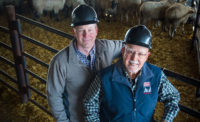The future of Mountain States Rosen includes instrument vision grading system, new food service strategy
In this video interview, CEO of Mountain States Rosen Dennis Stiffler discusses the company’s role in the industry and the future advancements in technology and food service strategies.
Andy Hanacek: First of all, Mountain States Rosen, talk about its role in the industry overall in terms of not just supporting, but preserving the industry, and how are you making the industry more viable through Mountain States Rosen? Initiatives, strategies, things like that?
Dennis Stiffler: Okay, Mountain States Rosen as you know, is a producer-owned co-op, and we are owned by a group of producers that was established in the late 1990s, early 2001. It's Mountain State Lamb Cooperative. It's a cooperative of producers. We've got about 165 members representing 17 states across the United States. Most of them are in the Mountain States, but we have members in Iowa, members in Texas, and other states like that.
Essentially what we're really trying to do strategically is to provide a marketing avenue for our shareholders which are producers, but that's only part of it. What we really have to do to be successful, three major things. One, the producers have to be profitable. Secondly, we've got to create demand for our product, and thirdly, we have got to maintain an infrastructure in order for all of the parts and pieces of the genetics, the management, the growing and backgrounding and feeding, the animal health aspects of it, the transportation, the packing processing and the go-to-market thing is there. That's really what we try to do, is line those dots up in terms of a very viable source supply of livestock through our co-op. We have our own feeding entity that helps us put products through and gives our membership an opportunity to finish lambs in conjunction, and then obviously we've had a long marketing strategy going out there and building that demand for our customers and our consumers.
Additional ContentCOO Ernie Davis discusses the Shepherds Pride Program and how reaching out to bloggers and local chefs raised awareness about how to prepare lamb products. Watch the video. Be sure to also read our March 2016 cover story on Mountain States Rosen. |
Hanacek: Talk a little bit about the success that Mountain States Rosen had in following these initiatives and these strategies over time.
Stiffler: I think the biggest statement of our success is that we were able to purchase this plant, because you can't do that without a viable track record. You can't do that without tremendous support from your producer growers who stepped in and they're part of it. This is their company. This is extremely important to them that we are successful, and then we've just done a wonderful job over the years, of building relationships in the marketplace with our retailers, with our food service operators, and even expansion into more global markets and exports, so I would say we have grown our membership, so that's a measure of success. We are still here, that is a major success, and we just pulled off an extremely strategic move in being able to capture this facility, which we have a 20 year relationship in, and now we're able to provide our producers with even more security, and more opportunity to grow, and our business model is working and we've been able to grow our business.
Hanacek: So what are the next steps for the company then, along these same lines? This is a big deal, purchasing this plant, as you said and as everybody knows. What are going to be the next measurements of success, the next advancements that the company is going to have to make to continue along this path?
Stiffler: We have several, and some of them involve technology, some of them involve expanding our footprints into case ready. We installed the instrument vision grading system in this plant a year ago, and we've been testing it, capturing data, sharing information with our producers. We think that system allows us to capture some data, that we can send very strong, positive signals back to those producers, in terms of the targets we need. Because the system allows us to identify like animals, so to speak, on an individual basis. Not a lot basis, not a on the average, but individually, and then feed that information back to our producers, as well as take advantage of that in our production planning, in our consistency and uniformity of product, and our go-to-market strategy.
So we're real excited about that. As you know, from having visited our facility in New York, in the Bronx, we have a very dynamic case ready program there, with multiple packaging footprints. We intend to do exactly the same thing here and expand into that, which will allow us to penetrate more markets, grow our business.
We also have a very important food service strategy going on, where we think that there's opportunity for growth. What we've seen in the food service industry, year over year, is growth in the lamb protein product, and it's not all the white tablecloth. It's casual, it's some semi-upscale, a good variety, a lot of underutilized cuts. So there's a tremendous opportunity there, and we've been working extremely hard with one of our food service groups in order to do some branding programs. So we're excited about what that has.
And then one of my particular objectives, and we've been a little slow to develop, but I think there's opportunity there, is the export market. We're going to see Taiwan and Japan both open to American lamb this year, which will give us opportunity. The U.S. government just closed on the TTP export trade agreement, which opens up additional markets, so I think there's a really good opportunity for increasing our export penetration of American lamb products.
Looking for a reprint of this article?
From high-res PDFs to custom plaques, order your copy today!





